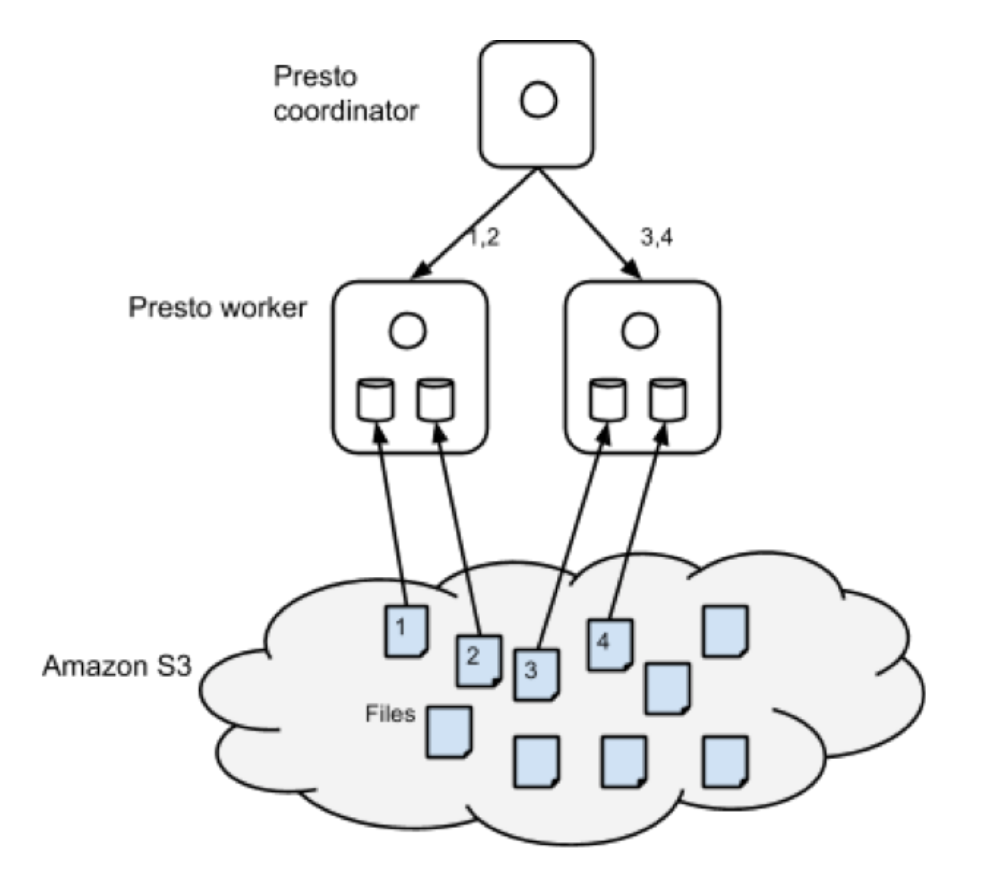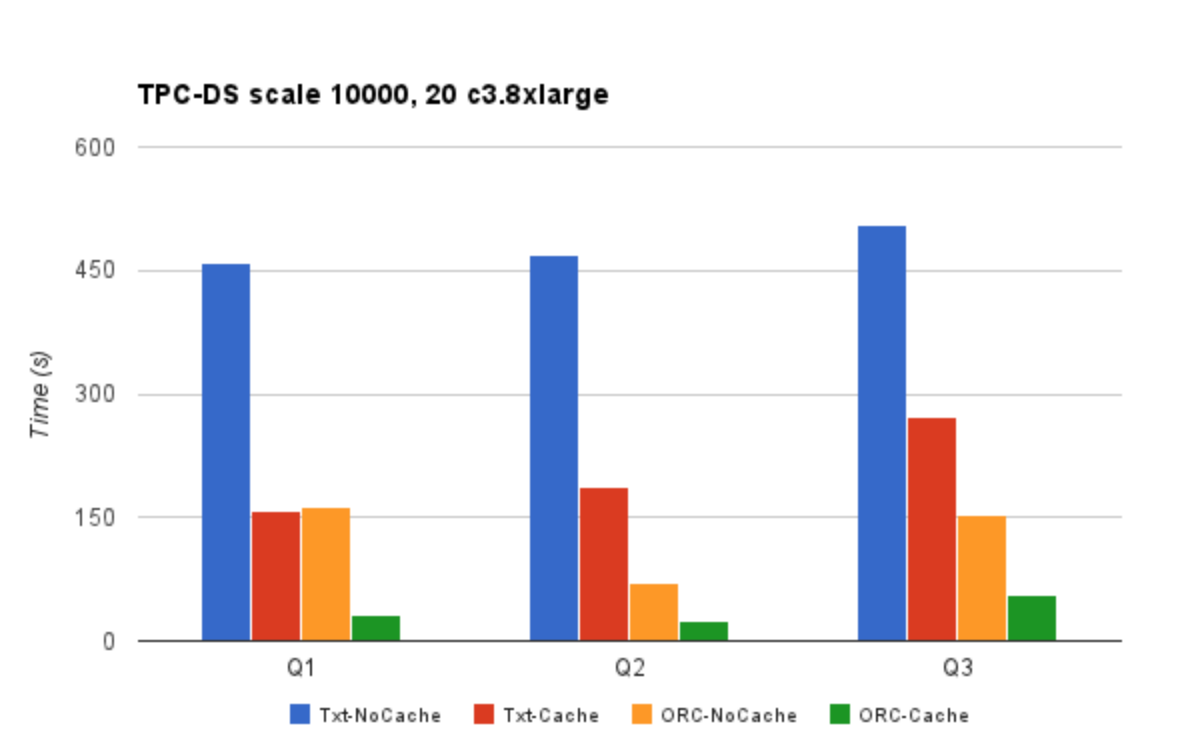Caching in Presto
Qubole’s Presto-as-a-Service is primarily targeted at Data Analysts who are tasked with translating ad-hoc business questions into SQL queries and getting results. Since the questions are often ad-hoc, there is some trial and error involved. Therefore, arriving at the final results may involve a series of SQL queries. By reducing the response time of these queries, the platform can reduce the time to insight and greatly benefit the business. In this post, we will talk about some improvements we’ve made in Presto to support this use-case in a cloud setting.
The typical use-case here is a few tables, each of which is a 10-100TB in size, living in cloud storage (e.g. S3). Tables are generally partitioned by date and/or by other attributes. Analyst queries pick a few partitions at a time, typically last one week or one month of data, and involve where clauses. Queries may involve a join with a smaller dimension table and contain aggregates and group-by clauses.
The main bottleneck in supporting this use-case is storage bandwidth. Cloud storage (specifically, Amazon S3) has many positives – it is great for storing large amount of data at low cost. However, S3’s bandwidth is not high enough to support this use-case very well. Furthermore, clusters are ephemeral in Qubole’s cloud platform. They are launched when required and shutdown when not in use. We recently introduced industry’s first auto-scaling Presto clusters which can add and remove nodes depending on traffic. The challenge was to support this use-case while keeping all the economic advantages of the cloud and auto-scaling.
The big opportunity here was that the new generation of Amazon instance types come with SSD devices. Some machine types also come with large amount of memory (r3 instance types) per node. If we’re able to use SSDs and memory as a caching hierarchy, this could solve the bandwidth problem for us. We started building a caching system to take advantage of this opportunity.
Architecture
The figure below shows the architecture of the caching solution. As part of query execution, Presto, like Hadoop, performs split computation. Every worker node is assigned one or more splits. For the sake of exposition, we can assume that one split is one file. Presto’s scheduler assigns splits to worker nodes randomly. We modified the scheduling mechanism to assign split to a node based on a hash of the filename. This assures us that if the same file were to be read for another query, that split will be executed in the same node. This gave us spatial locality. Then, we modified the S3 filesystem code to cache files in local disks as part of query execution. In the example below, if another query required reading file 2, it will be read by worker node 1 from local disk instead of S3 which will be a whole lot faster. The cache, like all others, contains logic for eviction and expiry. Some of the EC2 instances contain multiple SSD volumes and we stripe data across them.

We attempted to use MappedByteBuffer and explicit ByteBuffers for an in-memory cache, but quickly abandoned this approach – the OS filesystem cache did a good enough job and we didn’t have to worry about garbage collection issues.
One problem remained, though. What if a node was added or removed due to auto-scaling? The danger with using simple hashing techniques was that the mapping of files to nodes could change considerably causing a lot of grief. The answer was surprisingly simple – consistent hashing. Consistent hashing ensures that the remapping of splits to nodes changes gracefully. This blogpost does a great job of explaining consistent hashing from a developer’s point of view.
We used Guava extensively for the caching implementation. Guava has a in-memory pluggable cache. We extended it to support our use-case of maintaining on-disk cache. Furthermore, we used Guava’s implementation of consistent hashing.
Experimental Results
To test this feature, we generated a TPC-DS scale 10000 data on a 20 c3.8xlarge node cluster. We used delimited/zlib and ORC/zlib formats. The ORC version was not sorted. Here are table statistics.
Table Rows Text Text, zlib ORC, zlib
store_sales 28 billion 3.6 TB 1.4 TB 1.1 TB
customer 65 billion 12 GB 3.1 GB 2.5 GB
We used the following queries to measure performance improvements. These queries are representative of common query patterns from analysts.
| ID | Query | Description |
| Q1 | select * from store_sales where ss_customer_sk=1000; | Selects ~400 rows |
| Q2 | select ss_store_sk - sum(ss_quantity) as cnt from store_sales group by ss_store_sk order by cnt desc limit 5; | Top 5 stores by sales |
| Q3 | select sum(ss_quantity) as cnt from store_sales ssjoin customer c on (ss.ss_customer_sk = c.c_customer_sk)where c.c_birth_year < 1980; |
Quantity sold to customers born before 1980 Quantity sold to customers born before 1980 |

Txt-NoCache means using Txt format with caching feature disabled. The Txt-NoCache case suffers from both problems – inefficient storage format and slow access. Switching to caching provides a good performance improvement. However, the biggest gains are realized when caching is used in conjunction with the ORC format. There is a 10-15x performance improvement by switching to ORC and using Qubole’s caching feature. We incorporated Presto/ORC improvements courtesy Dain (@daindumb) in these experiments. Results show that queries that take many minutes now take a few seconds, thus benefiting the analyst use-case.
Conclusion
Presto, along with Qubole’s caching implementation, can provide the performance necessary to satisfy the Data Analysts while still retaining all the benefits of cloud economics – pay as you go and auto-scaling. We’re also in the process of open-sourcing this work.
Caching in Presto的更多相关文章
- 解读ASP.NET 5 & MVC6系列(8):Session与Caching
在之前的版本中,Session存在于System.Web中,新版ASP.NET 5中由于不在依赖于System.Web.dll库了,所以相应的,Session也就成了ASP.NET 5中一个可配置的模 ...
- ABP理论学习之缓存Caching
返回总目录 本篇目录 介绍 ICacheManager ICache ITypedCache 配置 介绍 ABP提供了缓存的抽象,它内部使用了这个缓存抽象.虽然默认的实现使用了MemoryCache, ...
- caching与缓存
通常,应用程序可以将那些频繁访问的数据,以及那些需要大量处理时间来创建的数据存储在内存中,从而提高性能.例如,如果应用程序使用复杂的逻辑来处理大量数据,然后再将数据作为用户频繁访问的报表返回,避免在用 ...
- Lind.DDD.Caching分布式数据集缓存介绍
回到目录 戏说当年 大叔原创的分布式数据集缓存在之前的企业级框架里介绍过,大家可以关注<我心中的核心组件(可插拔的AOP)~第二回 缓存拦截器>,而今天主要对Lind.DDD.Cachin ...
- 使用Enyim.Caching访问阿里云的OCS
阿里云的开放式分布式缓存(OCS)简化了缓存的运维管理,使用起来很方便,官方推荐的.NET访问客户端类库为 Enyim.Caching,下面对此做一个封装. 首先引用最新版本 Enyim.Cachin ...
- #数据技术选型#即席查询Shib+Presto,集群任务调度HUE+Oozie
郑昀 创建于2014/10/30 最后更新于2014/10/31 一)选型:Shib+Presto 应用场景:即席查询(Ad-hoc Query) 1.1.即席查询的目标 使用者是产品/运营/销售 ...
- presto的动态化应用(一):presto节点的横向扩展与伸缩
一.presto动态化概述 近年来,基于hadoop的sql框架层出不穷,presto也是其中的一员.从2012年发展至今,依然保持年轻的活力(版本迭代依然很快),presto的相关介绍,我们就不赘述 ...
- Asp.net Web.Config - 配置元素 caching
Asp.net Web.Config - 配置元素 caching 记得之前在写缓存DEMO的时候,好像配置过这个元素,好像这个元素还有点常用. 一.caching元素列表 元素 说明 cache ...
- 环境搭建 Hadoop+Hive(orcfile格式)+Presto实现大数据存储查询一
一.前言 Hadoop简介 Hadoop就是一个实现了Google云计算系统的开源系统,包括并行计算模型Map/Reduce,分布式文件系统HDFS,以及分布式数据库Hbase,同时Hadoop的相关 ...
随机推荐
- L1 loss 与 MSE
---恢复内容开始--- 今天在训练时遇到的问题 把损失函数由 MSE 改成 L1 Loss 的时候 Loss 有了明显的下降 以前一直觉得 MSE 相对来说会更好 ,因为求导的话有标签与结果的差值作 ...
- Tensorflow系列——Saver的用法
摘抄自:https://blog.csdn.net/u011500062/article/details/51728830/ 1.实例 import tensorflow as tf import n ...
- ADO.NET读取配置文件
App.config <?xml version="1.0" encoding="utf-8" ?> <configuration> & ...
- SQL server 的身份验证模式
windows身份验证(本机的ip地址或者localhost 或者.或者127.0.0.1) SQL Server身份验证(用户名和密码登录) 常见的错误代码18456(登录失败)和18470(账户被 ...
- OO第三次博客总结
一. 规格发展历史 从20世纪60年代开始,就存在着许多不同的形式规格说明语言和软件开发方法.在形式规格说明领域一些最主要的发展过程列举如下: 1969-1972 C.A.R Hoare撰写了&quo ...
- linux终端窗口字体缩放快捷键
环境:ubuntu16.04, 打开终端,有时候log输出一行显示不下 ‘ctrl’ + ‘-’字体缩小,一行显示更多的内容 ‘ctrl’ + ‘shift’ + ‘+’字体变大
- 关于charles抓不到js文件的问题
在清理了cookies后重新家在页面, charles抓不到js文件. 后来在https://zhidao.baidu.com/question/1802495173294727507.html 看到 ...
- pycrypto安装各种方法试了,最后这种最快速最方便
需要安装vs,然后按照如下步骤 这个不是在cmd中执行 而是在vs的命令行中执行
- 请给Array本地对象增加一个原型方法,它用于删除数组条目中重复的条目(可能有多个),返回值是一个包含被删除的重复条目的新数组。
这是牛客网上的一道题~ 题意:遇到重复元素就删除(留下第一个不重复的即可). 解题思路:双循环一遍数组,arr[i] == arr[j] 成立时,删除 arr[j],并将 arr[j] 直接push到 ...
- Codeforces 1105C: Ayoub and Lost Array(递推)
time limit per test: 1 second memory limit per test: 256 megabytes input: standard input output: sta ...
